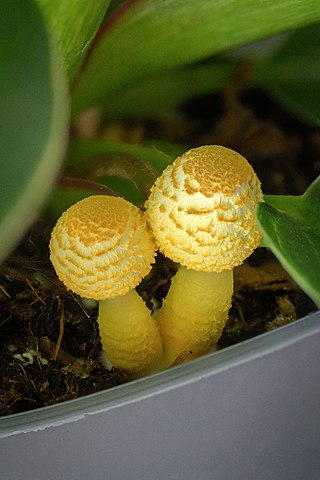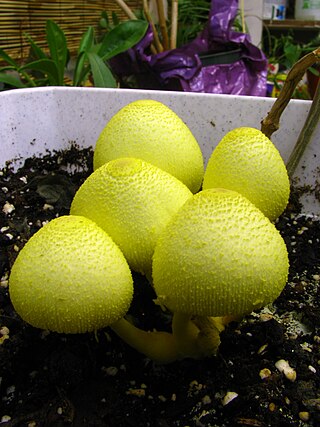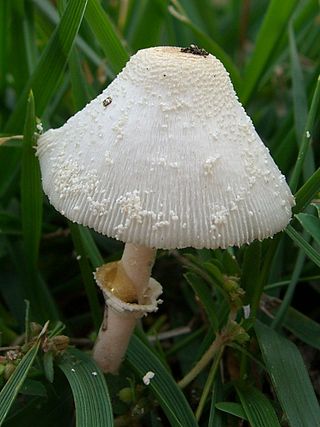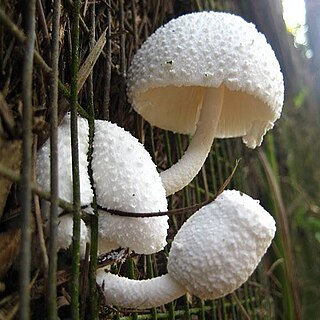
Leucocoprinus birnbaumii, commonly known as the flower pot parasol, yellow parasol, flowerpot parasol, or plantpot dapperling, is a species of gilled mushroom in the family Agaricaceae. It is common in the tropics and subtropics. However, in temperate regions, it frequently occurs in greenhouses and flowerpots, hence its common names of flowerpot parasol and plantpot dapperling. It is considered to be toxic if consumed.

Leucocoprinus is a genus of fungi in the family Agaricaceae. Its best-known member is the distinctive yellow mushroom Leucocoprinus birnbaumii, which is found in plant pots and greenhouses worldwide. The type species is Leucocoprinus cepistipes. The genus has a widespread distribution and contains over 80 recognised species, however many of these species are very scarcely recorded and little known with only a small number of Leucocoprinus species which are commonly observed. The majority of the species in this genus are exclusive to tropical environments however numerous species have become a common sight in plant pots and greenhouses resulting in them becoming well known worldwide.

Leucocoprinus cepistipes, is a species of fungus in the family Agaricaceae. It is typically found on wood debris, such as wood chips but may also grow in potted plants or greenhouses. Typical characteristics include a fine-scaled bell-shaped cap, a partial veil, and a tendency to bruise a yellow to brown when handled.

Leucocoprinus fragilissimus, commonly known as the fragile dapperling, is a species of gilled mushroom in the family Agaricaceae.

Leucocoprinus cretaceus is a species of mushroom producing fungus in the family Agaricaceae. It is likely tropical in origin although it was first documented in Europe where it was often found growing in greenhouses and bark beds. However many early observations conflate this species with Leucocoprinus birnbaumii or Leucocoprinus cepistipes despite sharing only some superficial similarities. This fungus is quite versatile even for a saprotroph and is often found growing in clusters on woodchips, sawdust and compost heaps as well as directly from the ground or on trees. It may also appear in plant pots and greenhouses in colder countries in which it is not well equipped to survive outside.
Leucocoprinus straminellus is a species of mushroom producing fungus in the family Agaricaceae. Like other Leucocoprinus species it may have originated in a tropical climate but now finds a home in plant pots, greenhouses and compost piles in many countries. Leucocoprinus straminellus is described as being similar to the more commonly known Leucocoprinus birnbaumii but it is smaller and a lighter shade of yellow with smaller spores that lack a germ pore. It is also described as being superficially similar to Leucocoprinus fragilissimus but slightly more robust with flesh that is less translucent.
Leucocoprinus flavescens is a species of mushroom-producing fungus in the family Agaricaceae.
Leucocoprinus griseofloccosus is a species of mushroom producing fungus in the family Agaricaceae.
Leucocoprinus magnicystidiosus is a species of mushroom producing fungus in the family Agaricaceae.
Leucocoprinus breviramus is a species of mushroom producing fungus in the family Agaricaceae.
Leucocoprinus medioflavus is a species of mushroom producing fungus in the family Agaricaceae.
Leucocoprinus castroi is a species of mushroom producing fungus in the family Agaricaceae.
Leucocoprinus elaeidis is a species of mushroom-producing producing fungus in the family Agaricaceae. In the local language, it is commonly known as elela.
Leucocoprinus subglobisporus is a species of mushroom-producing fungus in the family Agaricaceae.
Leucocoprinus martinicensis is a species of mushroom producing fungus in the family Agaricaceae.
Leucocoprinus bonianus is a species of mushroom producing fungus in the family Agaricaceae.
Leucocoprinus tanetensis is a species of mushroom producing fungus in the family Agaricaceae.
Leucocoprinus acer is a species of mushroom producing fungus in the family Agaricaceae.
Leucocoprinus inflatus is a species of mushroom producing fungus in the family Agaricaceae.
Leucocoprinus microlepis is a species of mushroom producing fungus in the family Agaricaceae.




